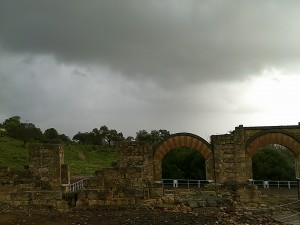Ancient History
Take any Islamic Civilization or Islamic Art class and you will inevitably study Granada. Granada and Córdoba have some of the best conserved buildings from before the Catholic Kings took over Spain, the best examples of which are the Gran Mezquita de Córdoba (in Córdoba) and the Alhambra (in Granada). Walking through some of the neighborhoods here puts you in touch with buildings and streets older than the idea of exploring the Americas. In the U.S., if something’s really really old it might have been built in the 1800s. Here, that’s new and shiny.
Last week we took a trip to Córdoba for our Art and Architecture class so that we could see Madinat Al-Zahra, the city built exclusively for the Caliphate of Córdoba by Abd Al-Rahman III, and the Gran Mezquita de Córdoba.
In 929, the emir Abd Al-Rahman III decided that since he was so rich, he didn’t have to be ruling a measly emirate, still linked to Damascus, so he declared himself the caliph and established the Caliphate of Córdoba. After doing this, he decided to build a city for himself. This city is Madinat Al-Zahra, outside of Córdoba. It was built with the finest materials and adorned with the finest decoration, because it was meant to be a city of brilliance, the symbol of the caliphate’s power. As time wore on and the caliphate was divided into the Taifas, then defeated by the Almorávides, and then the Almorhades, and then the Catholic Kings, Madinat Al-Zahra was abandoned and buried in the sands of time. Until some farmers outside of Córdoba happened upon some stones too perfectly arched to be natural, and caused an archeological uproar. The mythical city of Madinat Al-Zahra had been found. Now the city is a museum, and you can visit it and walk on the very floors that the former kings of Andalucía laid. It’s unreal. I’ve never felt so much like I was in a history book. In my classes we study the Independent Emirate, the Caliphate, the Reigns of the Taifa and their art, but it is something very different to be able to stand there and run your fingers across the deeply carved capitals of the red marble columns.
Being in the mosque was another experience. I’ve seen iconic pictures of the forest of red-and-white striped arches printed on the glossy pages of books, and to stand looking up at them gave me chills. Not only is the mosque still largely intact from when it was finished during the Caliphate, but parts of the Christian church it was built on top of still exist as well. The grandeur and the detail are unlike anything else, but the part that really blew my mind was that it was still standing. Through the years of Andalusian turmoil, it is still standing, and around us swirled the whispers of the worshippers who had come through the ages, the whispers of the architects and kings who shaped Spanish history.
There is something magical about being one of millions to have laid your feet down in the same place, and to have stood in awe. There is something beautiful about stopping to gaze and reflect in a building that has held thousands of years of human beauty and suffering and discovery and questions.
